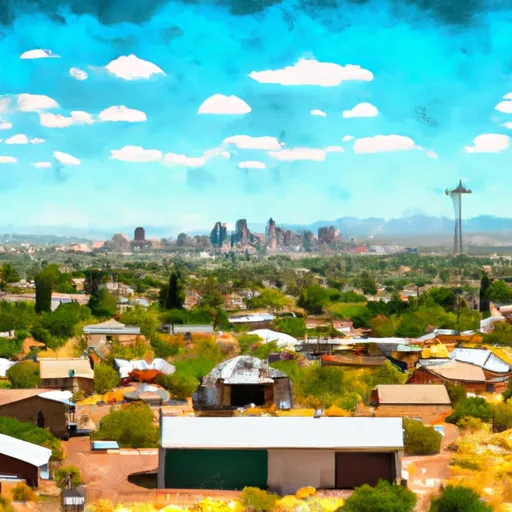-
 Snoflo Premium
Snoflo Premium
Get unlimited access to all our content
With no Ad interruptions! - Start Your Free Trial Login with existing account
Why
Eden Index
Climate
7.7
•
Recreation
3.1
•
Community
•
Safeguard
4.2/10

Why, Arizona is a small town located in the southwestern part of the state. It has a desert climate, characterized by hot summers and mild winters. Summers are typically dry, with average temperatures reaching into the high 90s and occasionally exceeding 100°F. Winters are mild, with average temperatures ranging from the mid-50s to the low 70s.
Hydrology in Why, Arizona is mainly influenced by the presence of the Sonoran Desert. The area experiences limited rainfall, with an average annual precipitation of around 8 inches. The desert landscape features arid washes and intermittent streams, which can occasionally flow during periods of heavy rainfall. The hydrology of the region is also important for the various plants and animals that have adapted to this harsh environment.
Outdoor recreation opportunities in Why, Arizona are abundant. The nearby Organ Pipe Cactus National Monument offers stunning landscapes and diverse ecosystems for hiking, camping, and wildlife watching. Visitors can explore the Sonoran Desert's unique flora and fauna, including the iconic organ pipe cactus. The park also provides opportunities for stargazing and photography. Additionally, nearby Cabeza Prieta National Wildlife Refuge offers opportunities for birdwatching, wildlife photography, and hiking in its pristine desert habitat. Overall, Why, Arizona, with its desert climate, limited hydrology, and proximity to natural wonders, provides an ideal setting for outdoor enthusiasts to explore and appreciate the beauty of the desert ecosystem.
What is the Eden Index?
The Snoflo Eden Index serves as a comprehensive rating system for regions, evaluating their desirability through a holistic assessment of climate health, outdoor recreation opportunities, and natural disaster risk, acknowledging the profound impact of these factors on livability and well-being.
Climate Health Indicator (CHI): 7.7
Why receives approximately
198mm of rain per year,
with humidity levels near 74%
and air temperatures averaging around
22°C.
Why has a plant hardyness factor of
9, meaning
plants and agriculture in this region tend to thrive here all year round.
By considering the ideal temperature range, reliable water supplies, clean air, and stable seasonal rain or snowpacks, the Climate Health Indicator (CHI) underscores the significance of a healthy climate as the foundation for quality living.
A healthy climate is paramount for ensuring a high quality of life and livability in a region, fostering both physical well-being and environmental harmony. This can be characterized by ideal temperatures, reliable access to water supplies, clean air, and consistent seasonal rain or snowpacks.
Weather Forecast
Streamflow Conditions
Lower Gila
Area Rivers
Lower Gila
Snowpack Depths
Lower Gila
Reservoir Storage Capacity
Lower Gila
Groundwater Levels
Recreational Opportunity Index (ROI): 3.1
The Recreational Opportunity Index (ROI) recognizes the value of outdoor recreational options, such as parks, hiking trails, camping sites, and fishing spots, while acknowledging that climate plays a pivotal role in ensuring the comfort and consistency of these experiences.
Access to outdoor recreational opportunities, encompassing activities such as parks, hiking, camping, and fishing, is crucial for overall well-being, and the climate plays a pivotal role in enabling and enhancing these experiences, ensuring that individuals can engage in nature-based activities comfortably and consistently.
Camping Areas
| Campground | Campsites | Reservations | Toilets | Showers | Elevation |
|---|---|---|---|---|---|
| Twin Peaks - Organ Pipe Cactus National Monument | 208 | 1,711 ft | |||
| Gunsite Wash Dispersed | None | 1,795 ft | |||
| Gila Bend Military | None | 862 ft | |||
| Darby Wells Rd Dispersed | None | 1,734 ft | |||
| Dennison Campground - Ajo Regional Park | None | 1,470 ft |
Nearby Ski Areas
Catastrophe Safeguard Index (CSI):
The Catastrophe Safeguard Index (CSI) recognizes that natural disaster risk, encompassing floods, fires, hurricanes, and tornadoes, can drastically affect safety and the overall appeal of an area.
The level of natural disaster risk in a region significantly affects safety and the overall livability, with climate change amplifying these risks by potentially increasing the frequency and intensity of events like floods, fires, hurricanes, and tornadoes, thereby posing substantial challenges to community resilience and well-being.
Community Resilience Indicator (CRI):
The Community Resilience Indicator (CRI) recognizes that education, healthcare, and socioeconomics are crucial to the well-being of a region. The CRI acknowledges the profound impact of these elements on residents' overall quality of life. By evaluating educational resources, healthcare accessibility, and economic inclusivity, the index captures the essential aspects that contribute to a thriving community, fostering resident satisfaction, equity, and social cohesion.

